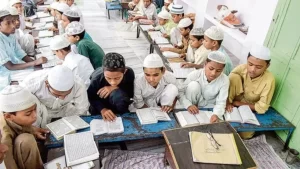
By Dr Birbal Jha
One wouldn’t be able to find a more amusing place other than Mithila in Bihar, where people don’t use alarms to get up; they rather wake up at live melodies which can be heard all around and are sung by people to begin the day. The land of Goddess Sita, Mithila is the only human inhabitation where people wake up at Parati, a kind of morning folk song unlike one in a contrary culture where they get up at cockcrow.
Such a musical tradition of ‘Parati’ is well maintained more particularly by women community apart from elderly males. ‘Parati’ is a form of folk song the melody of which pleases the ears of men and women around in the early morning. The term ‘Parati’ is derived from the Sanskrit word ‘Praatah’ meaning morning. Here this refers to a song in practice in the early dawn.
This kind of daily routine of the people of Mithila has made their lives distinctive and alluring. Mithila Paintings, as many would have heard about, are found in every next door in the villages.
Accordingly, the way music and art exist there; it portrays every house as a centre of Art and Music. People, more particularly women there, are inherently talented in music, irrespective of their educational backgrounds. However, in Mithila, there has been a noticeable rise of literacy rate in the recent times in comparison to the past decades.
The wonderful and unique tradition of music and singing has been followed in the belt generation after generation which is worth beholding and listening to. The elderly have played a big role in maintaining such a melodious uniqueness conventionally. However, there has presently been a decline in these traditional melodies in particular and cultural charisma in general, thanks to the mass migrants in search of their livelihoods flooding out of Mithila.
The musical culture begins with a child-birth in Mithila and continues until before a soul departs. Remarkably, people celebrate their lives here. Each of the events, throughout a person’s life, has a different lore of music, art, and culture. A guest is greeted with a welcome song on arrival and is given farewell with a valedictory song. A different song is sung for the hospitality of the guests at the time of offering lunch or dinner.
The Mithila culture is indeed an incredible one especially for those interested in music, painting and Arts. Those outsiders, who are in pursuit of peace and tranquility, must visit and spend at least some days in Mithila. ‘Brahmasa’ is a scientific collection of songs devoted to each of 12 months of the year. Each season has its own ear candy song. The rhythmic tones change in spring and so is the case with the advent of rainy season.
Mithila geographical is a land of the country which hinges on rainfalls for agriculture. To please Indradev, Rain God, a song is there for the purpose. This is similar too, in case a drought occurs and people suffer, they sing Jat-Jatin, a variety often sung at sultry nights. The language of Mithila is Maithli which is a synonym of Goddess Sita who was born there. The famed English linguist George Grierson once said, “Maithli is the sweetest language of the world”.
Describing the beauty and mellowness of the language, he added: “When two Maithil women fight with each other, they appear to be singing songs.” In this act, they call fire or the Sun as a witness. Life is a celebration there. Varieties of songs are in place for different occasions. To mark the birth and arrival of a child in the family, there is a special song called ‘Sohar’. To mark the sixth day of birth, there is yet another song widely known as the ‘Chhatihari’. Normally, three years later, under the ritual of ‘Mundan Sanskaar,’ the hair of the male child is shorn off, with scissors for the first time.
Worshipping God with the Mundan song is in tradition. Such singing is accompanied by traditional instruments, the drum in them being a must. On 5th, 7th or 9th years of a child, there is yet another traditional ceremony known as ‘Upnayan Sanskaar’ which is considered as very auspicious. On this day of the ceremony, the head of the male child is shaved off with a customized blade for the first time.
This is called ‘ Yagyopaveet ’ wherein participation of people from all castes and creeds is mandatorily welcome. The Janeu song adds beauty and flavor to the ceremony along with several musical instruments including drums and flutes.
Mithilanchal has a special song for the well-being and health of a person as well. Wishes and blessings are lyricised and then a piece of music is effected. This melody is called the ‘Parichan song’. Kissing the child is called ‘Chumaun’. Women in groups enchant the Chumaun song and create an unparallel scene.
The child has Tilak, a vertical smearing of red holy powder on his forehead, and wears red and yellow clothes and seeks the blessings of his elders. There comes a wedding ceremony with fanfare. The father of the newly wedded couple is called ‘Samdhi’ who enjoys a high status on their visit to each other’s place. Even sarcasm and abuses are hurled in the shape of a song known as Dahkan. Romanticism reaches the climax, they burst into laughter and such an abuses are is taken as fun to amuse and never taken otherwise.
Great is the music culture of Mithila, which is a philosophy in itself! The place of a daughter in Mithila is supreme. She is said to be in every particle of soil. It is because Sita was born out of it. Showing great compassion and unbound love there is a ‘Samdaun song’. Both males and females can be seen in tears.
This makes an impression that there is a song even for inviting wails as well. This distinctive culture henceforth does necessitate at least one visit to the ‘Land of Music’ so let’s visit Mithila and delve deep into the musical life there.
Dr Birbal Jha is managing director, Lingua Multiservices Pvt Ltd, having a popular Trademark brand British Lingua and Chairman of Mithilalok Foundation, working for Socio-economic and Cultural Development.)






